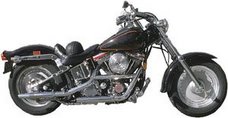http://www.classicalpontiac.com/restoration/4.html
For those of you who may be on a budget and still want to have longer lasting and non-rusting headers. You may want to try and coat them yourself. I had planned on the old BBQ black paint again. Then I came across a product called CERMAKROME made by TechLine. Its a high temp thermal barrier metallic/ceramic coating. IÕm sure there are other coatings on the market. I just happened to use this particular one.
In order to coat the headers properly you will need access to the following equipment and supplies:
a. sand blaster
b. airbrush or touchup sprayer
c. oven/heat source
d. 6 aluminum oven liners approx. 16"x18"(from supermarket)
e. fiber glass house insulation
The coating instructions are: sand blast the headers. Make sure all paint, rust and oils are 100 percent off. Do not bead blast. It doesn't open the metal surface like sand does or removes rust completely. Wipe parts with alcohol thinner or acetone. Do not use petroleum-based products. Warm parts to approximately 90 degrees. I used my wood stove in the garage. A heat gun would work also. This is to make sure no moisture is in the metal. The instructions say to spray a light fog on the radius first, then the rest of the pipe. I found that this left dry spots that when the over spray from spraying the rest of the pipe, left a bumpy, orange peel like texture. I found that by painting like I normally paint a part it work better. I kept a wetness to all of the area I was working on then moved down the pipe. Which kept the coating smooth looking and the finished results were far better.
But remember not to get it to thick.
I used an airbrush. I think a touchup gun may be too large to use. At least for me. Seeing that the pipes were pre-heated the coating starts to dry quickly. I hung the pipes from a wire so I could get 360 degrees around them. This let me start at the top and work my way down and around. I did spray the hard to get to areas first, of the section I was working on. Like where the pipe tubes come together as a group. Continue until the header is totally coated. The coating should be a .001" to .0015" thick. I couldn't mike it so I just put on a medium paint type thickness. The coating is now a light green color. The part now needs to be heated to about 150 degrees in an oven to dry. (10 min) The dry coating is a light gray. Then the part needs to be baked at 500 degrees for one hour. No you don't have to baste.
I used the household oven. Here's how. Seeing the oven door wouldn't close with the pipe in there. I extended the oven door. I put the pipe in the stove from rear corner to the opposite front corner. I wired the front corner to hang up to the top of the open end of the oven. I closed the door as far a possible. This will leave a tri-angle shape for the sides and a longer rectangle opening on top. I then cut and formed the oven pans to the tri-angles and made them about 1 _" thick. I stuffed them with the insulation. I did the same for the top opening. The oven pans are like aluminum pie pans, very easy to bend. This was also wrapped with aluminum foil to help seal on the oven and door areas. Of coarse you want to have this done prior to painting the pipe. Make sure that any oven switches (light inside) get insulated from the heat or they kinda melt. Make sure they have foil around them and are exposed to the outside of the stove if you can. I put an oven pan on the floor of the oven just in case.
There were no toxic type fumes or smells. Yes there was a baked surface smell but it wasn't that strong. I would try to close off the kitchen and open a window. After baking at 500 degrees for an hour let cool, do not quench. There will be a light gray /dirty white color on the pipe. Now take some "00" steel wool or medium scotch brite pads and start to sand the surface. What will appear will be a metallic coating. Which looks a lot like the "Jet Coatings", that you pay big $$s for, on the outside of your pipes. If you had a car undercoating type spray wand I'm sure you could also paint the inside. This is very similar to powder coating because the coating is made up of aluminum powder and phosphate/chromic solution. You then can keep sanding until they are polished or close to it.
There are several aspects I like about this type of coating. You can coat just about anything that can withstand 500 degrees (not internal engine parts). Also to touch up a nick in the coating, for headers, is warm engine, touch up then drive. This coating is very tuff but will scratch or chip if hit hard enough with some thing hard. Like a wrench when tightening the header bolts. The coating has been tested to a continuous 1200 degrees. It won't turn color and keeps the heat inside the pipe vs. the engine compartment. It can be cleaned up and thinned with water. Unless it dries first, so be careful about spillage.
Saturday, June 23, 2007
Subscribe to:
Post Comments (Atom)


No comments:
Post a Comment